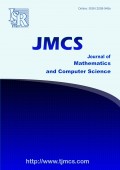A Novel Sizing Methodology Based on Match Evaluation Method for Optimal Sizing of Stand-alone Hybrid Energy Systems Using Nsga-ii
-
2552
Downloads
-
3416
Views
Authors
Mohammad Ali Yazdanpanah Jahromi
- Department of Mechanical Engineering, University of Sistan and Baluchestan, Zahedan, Iran.
Said Farahat
- Department of Mechanical Engineering, University of Sistan and Baluchestan, Zahedan, Iran.
Seyed Masoud Barakati
- Department of Power Electronic Engineering, University of Sistan and Baluchestan, Zahedan, Iran.
Abstract
Wind and solar energy technologies offer clean and renewable energy sources, and are essential
components of sustainable energy future. The current paper presents a new methodology for size
optimization of stand-alone Wind/PV energy systems. The principal objective of this study is to
maximize the electricity match rate between demand and supplies, able to accomplish the energy
requirements of a given load distribution, for a specific site. Mathematical models of hybrid
components are exploited to estimate the total output power using solar radiation, temperature
and wind speed data, collected on the site of Zabol, located in Sistan and Baluchestan, Iran. Then, a
new methodology has been proposed which can obtain the optimal size of each hybrid component.
The objective functions are considered based on supply/demand match evaluation criteria,
minimizing the inequality coefficient (IC) and also maximizing the correlation coefficient (CC),
simultaneously. The elitist non-dominated sorting genetic algorithm (NSGA-II), which is one of the
multi-objective evolutionary algorithm (MOEA), have been employed for a hybrid stand-alone
renewable energy power system (Wind/PV) to find the optimal size of each components. The
Pareto-optimal solution is obtained in order to have higher-level decision. The designers can select
the best configuration among the Pareto set which fits their desire.
Share and Cite
ISRP Style
Mohammad Ali Yazdanpanah Jahromi, Said Farahat, Seyed Masoud Barakati, A Novel Sizing Methodology Based on Match Evaluation Method for Optimal Sizing of Stand-alone Hybrid Energy Systems Using Nsga-ii , Journal of Mathematics and Computer Science, 5 (2012), no. 2, 134 - 145
AMA Style
Jahromi Mohammad Ali Yazdanpanah, Farahat Said, Barakati Seyed Masoud, A Novel Sizing Methodology Based on Match Evaluation Method for Optimal Sizing of Stand-alone Hybrid Energy Systems Using Nsga-ii . J Math Comput SCI-JM. (2012); 5(2):134 - 145
Chicago/Turabian Style
Jahromi, Mohammad Ali Yazdanpanah, Farahat, Said, Barakati, Seyed Masoud. "A Novel Sizing Methodology Based on Match Evaluation Method for Optimal Sizing of Stand-alone Hybrid Energy Systems Using Nsga-ii ." Journal of Mathematics and Computer Science, 5, no. 2 (2012): 134 - 145
Keywords
- Hybrid Wind/PV systems
- multi-objective optimization
- sizing method
- electricity match rate
MSC
References
-
[1]
Mehdi Vafaei, Optimally-Sized Design of a Wind/Diesel/Fuel Cell Hybrid System fo Remote Community , Master of Applied Science Electrical and Computer , Engineering University of Waterloo (2011)
-
[2]
Daming Xu, Longyun Kang, Liuchen Chang, Binggang Cao, Optimal Sizing of Standalone Hybrid Wind/PV Power Systems Using Genetic Algorithms, presented at the IEEE, (2005)
-
[3]
Hongxing Yang, Wei Zhou, Lin Lu, Z. Fang, Optimal sizing method for stand-alone hybrid solar–wind system with LPSP technology by using genetic algorithm, Solar Energy, ELSEVIER, (2008), 354–367
-
[4]
Zhou Wei, Simulation and Optimum Design of Hybrid Solar-Wind and Solar-Wind-Diesel Power Generation Systems, Doctor of Philosophy, The Hong Kong Polytechnic University (2007)
-
[5]
D. B. Nelson, M. H. Nehrir, C. Wang, Unit sizing and cost analysis of stand-alone hybrid wind/PV/fuel cell power generation systems, Renewable Energy, ELSEVIER, (2006), 1641 – 1656
-
[6]
Zhou Wei, Yang Hongxing, One Optimal Sizing Method for Designing Hybrid Solar-Wind- Diesel Power generating Systems, presented at the Zhou Wei, Yang Hongxing (2007)
-
[7]
D. B. Nelson, M. H. Nehrir, Unit Sizing of Stand-Alone Hybrid Wind/PV/Fuel Cell Power Generation Systems, IEEE, (2005), 1-7
-
[8]
B. Ould. Bilala, V. Samboua, C. M. F Kébé, P. A. Ndiaye, M. Ndongo, Methodology to Size an Optimal Stand-Alone PV/wind/diesel/battery System Minimizing the Levelized cost of Energy and the CO2 Emissions, Energy Procedia, ELSEVIER, (2012), 1636 – 1647
-
[9]
R. Luna-Rubio, M. Trejo-Perea, D. Vargas-Vazquez, G. J. Rıos-Moreno, Optimal sizing of renewable hybrids energy systems: A review of methodologies, Solar Energy, ELSEVIER, (2012), 1077– 1088
-
[10]
Y. S. Zhao, J. Zhan, Y. Zhang, D. P. Wang, B. G. Zou, The Optimal Capacity Configuration of An Indepebdent Wind/PV Hybrid Power Supply System Based on Improved PSOAlgorithm, , (2006)
-
[11]
Javed Dhillon, Multi objective Obtimization of Power Dispatch Problem Using NSGA-II, Master of Engineering Power Systems & Electric Drives, Thapar University, Patiala (2009)
-
[12]
Rodolfo Dufo-Lopez, Jose L. Bernal-Agustin, Multi-objective design of PV– wind– diesel– hydrogen– battery systems, Renewable Energy, ELSEVIER, (2008), 2559– 2572
-
[13]
Miguel Rios Rivera, Small Wind/Photovoltaic Hybrid Renewable Energy System Optimization, Master of Science, Electrical Engineering, Puerto Rico, Mayagüez Campus (2008)
-
[14]
Eftichios Koutroulis, Dionissia Kolokotsa, Antonis Potirakis, Kostas Kalaitzakis, Methodology for optimal sizing of stand-alone photovoltaic/wind-generator systems using genetic algorithms, Solar Energy, ELSEVIER, (2006), 1072–1088
-
[15]
Francesca Jane Born, Aiding Renewable Energy Integration through Complimentary Demand- Supply Matching, Doctor of Philosophy, Energy Systems Research Unit, University of Strathclyde (2001)
-
[16]
Sana Waqas, Development of an Optimisation Algorithm for Auto sizing Capacity of Renewable and Low Carbon Energy Systems , Master of Science, Department of Mechanical Engineering, University of Strathclyde Engineering (2011)
-
[17]
Daming Xu, Longyun Kang, Binggang Cao, The Elitist Non-dominated Sorting GA for Multiobjective Optimization of Standalone Hybrid Wind/PV Power Systems, , Applied Sciences (2006)

